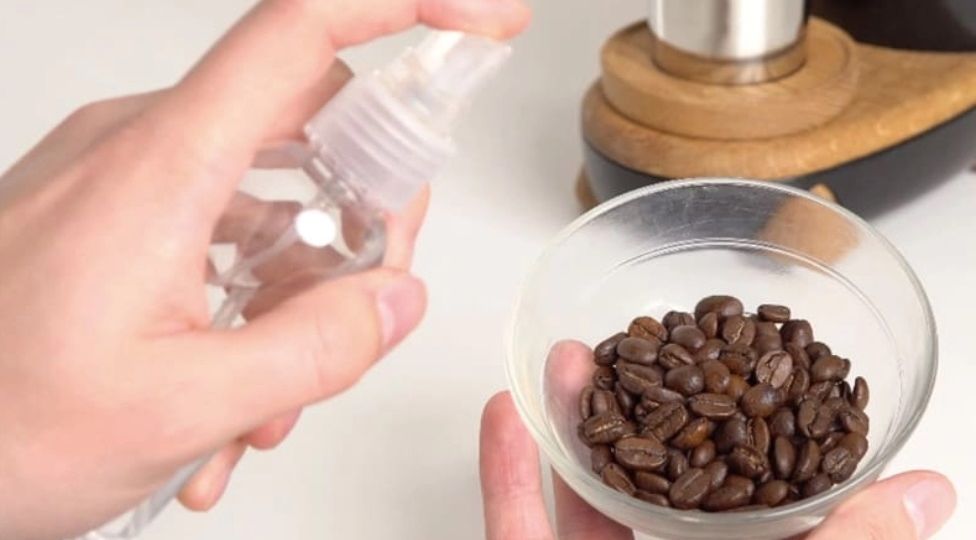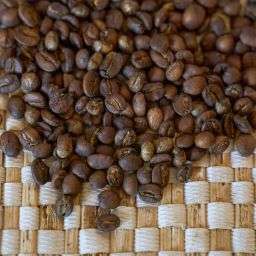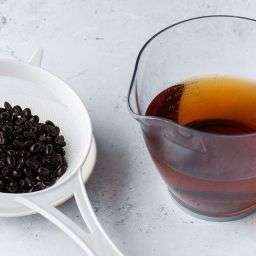
Spraying coffee beans before grinding has emerged as a cutting-edge technique among coffee aficionados aiming to elevate the flavor and uniformity of their brew. This method involves lightly misting coffee beans with water before the grinding process.
Its popularity is not without merit; it addresses common issues associated with grinding coffee, such as static and inconsistent grind sizes, which can detract from the overall quality and taste of the coffee. By introducing a minimal amount of moisture, this technique helps in achieving a cleaner, more consistent grind, enhancing the brewing accuracy and ultimately improving the coffee experience.
Key Takeaways
- Reduced Static Cling: A primary benefit of spraying coffee beans before grinding is the significant reduction in static electricity. This reduction minimizes the mess typically caused by coffee grounds sticking to the grinder and surrounding areas, facilitating a cleaner grinding process.
- Enhanced Brewing Recipe Accuracy: The technique improves brewing recipe accuracy by ensuring all weighed beans are used in the brew without waste. This accuracy is crucial for consistent coffee quality, making the practice especially valuable for enthusiasts and professionals alike.
- Decreased Grinder Maintenance: By preventing coffee grounds from clinging to the grinder’s internal surfaces, this method reduces the need for frequent cleaning and maintenance of the grinder. Less residue means a smoother operation and extends the lifespan of the grinder.
- Optimized Moisture Content: Correct application of the technique—spraying just enough to dampen without soaking the beans—ensures the optimal moisture content for grinding. This optimization is key to preventing adverse effects like clogging or uneven grinding.
- Versatility Across Brewing Methods: Whether you’re preparing espresso, French press, or any other brewing method, spraying coffee beans can enhance the grinding process. It is particularly beneficial when grinding directly into a portafilter or a separate container, reducing static and mess for various brewing techniques.
How to Spray Coffee Beans
Spraying coffee beans before grinding is a nuanced process that enhances the grinding and brewing experience. The objective is to apply a fine mist to the beans, ensuring even moisture distribution without over-saturating them. Here’s how to execute this technique effectively:
- Preparation: Begin by selecting the amount of coffee beans you plan to grind. Place them in a wide, shallow container to maximize exposure to the mist.
- Misting the Beans: Use a clean, fine mist spray bottle filled with fresh, filtered water. Position the nozzle a few inches above the coffee beans. Aim for a gentle, even coating across all the beans. Typically, one to two light sprays should suffice, depending on the quantity of beans.
- Even Distribution: After spraying, gently shake or stir the beans to ensure the moisture is evenly distributed among them. This step is crucial for preventing clumping and ensuring that each bean receives the benefits of the mist.
- Immediate Grinding: Once the beans are lightly misted and evenly coated, proceed to grind them as usual. This immediate action helps leverage the moisture’s benefits while minimizing any potential negative effects of prolonged exposure to water.
Choosing the Right Spray Bottle
The selection of the appropriate spray bottle is crucial for applying this technique successfully. The goal is to produce a fine, even mist that lightly coats the beans without drenching them. Here are key considerations when choosing a spray bottle:
- Nozzle Quality: Look for a spray bottle with an adjustable nozzle that can produce a fine mist. The quality of the mist is critical for achieving even moisture distribution without over-wetting the beans.
- Size and Capacity: A small to medium-sized bottle is ideal, as it allows for precise control and easy handling during the spraying process. A capacity of 2 to 8 ounces is generally sufficient for personal or small-scale use.
- Material: Opt for a bottle made from food-safe materials. Glass is a popular choice for its durability and lack of interaction with water, ensuring that no unwanted chemicals leach into your coffee beans.
- Recommendations: Spray bottles designed for cosmetic use, such as those used for hair products or fine fragrances, are often well-suited for this task. These bottles are engineered to dispense liquids in a fine, even mist, making them perfect for the precise application needed for coffee beans.
Mastering the technique of spraying coffee beans before grinding involves both the method of application and the choice of tools. By following these detailed steps and selecting the right spray bottle, coffee enthusiasts can enhance their brewing process, achieving a more consistent grind and a fuller, richer coffee flavor.
Common Concerns with Spraying Coffee Beans
While the technique of spraying coffee beans before grinding offers numerous benefits, there are potential drawbacks that enthusiasts should be aware of. Addressing these concerns can help in optimizing the practice for better results.
- Uneven Moisture Distribution: One of the primary challenges is achieving uniform moisture distribution across all beans. Inconsistencies in moisture can lead to uneven grinding, affecting the overall flavor profile of the coffee. To mitigate this, ensure a fine mist and shake the beans post-spraying to distribute moisture evenly.
- Risk of Over-Moistening: Applying too much water can saturate the beans, leading to issues such as clumping or clogging in the grinder. This over-moistening can negatively impact the grinding process and the flavor extraction during brewing. Practitioners should aim for a light mist to avoid these complications.
- Extended Grinding Time: The added moisture may soften the beans slightly, potentially increasing the time required to grind them to the desired consistency. This can be a minor inconvenience and is worth considering when planning your coffee preparation routine.
- Impact on Grinder Maintenance: Moisture introduced into the grinder can accumulate over time, potentially causing clogs or affecting the grinder’s performance. Regular cleaning and maintenance of the grinder are essential to prevent any adverse effects and ensure its longevity.
- Varied Impact on Flavor: The effect of spraying coffee beans on the flavor profile can be subjective. While some may notice an enhancement in flavor extraction, others may find the difference minimal. Experimentation and personal taste preferences play a significant role in determining the value of this technique.
Advanced Tips and Precautions
To maximize the benefits of spraying coffee beans before grinding, consider the following advanced tips and precautions:
- Assess Environmental Humidity: The effectiveness of this technique can be influenced by the ambient humidity. In drier environments, the benefits may be more pronounced due to the reduction in static electricity. Adjust the amount of water used based on your local humidity levels to prevent over-moistening.
- Consider Grinder Type: The technique is generally beneficial across various grinder types, but it’s essential to consider the specific characteristics of your grinder. Some grinders may be more susceptible to clogs or maintenance issues when exposed to moisture. If unsure, start with a minimal amount of water and adjust based on your observations and the grinder’s performance.
- Precautions for Grinder Maintenance: While this method can reduce the need for frequent cleaning due to less static, it introduces moisture, which requires attention. Ensure your grinder is dry and clean after use to avoid rust or buildup inside the machine. This precaution helps maintain the grinder’s efficiency and durability.
- Trial and Adjustment: As with any coffee brewing technique, personal preference plays a significant role. Start with a conservative amount of water and adjust based on the results. Experimenting with different levels of moisture can help you find the perfect balance for your taste and grinder setup.
Incorporating these insights and precautions can enhance the effectiveness of the coffee bean spraying technique, leading to an improved coffee brewing experience.
FAQs
Will spraying coffee beans before grinding make them stick to the grinder?
Contrary to what one might assume, spraying coffee beans with a fine mist of water before grinding does not make them stick to the grinder. Instead, this practice is known to prevent static electricity from building up. Static electricity can cause coffee grounds to scatter and cling to the grinder and surrounding areas. By lightly moistening the beans, static is reduced, leading to a more even and consistent grind without the mess usually caused by static cling.
Can I spray coffee beans in advance?
It is recommended to spray coffee beans just before grinding rather than in advance. Spraying them right before grinding ensures that the beans are evenly coated with water, which helps in reducing static and achieving a uniform grind. Pre-spraying and leaving the beans to sit could lead to uneven moisture absorption among the beans, potentially affecting the grind consistency and freshness of the coffee.
Can I use a different liquid to spray the coffee beans?
While water is the most commonly recommended liquid for spraying coffee beans due to its neutrality and availability, some enthusiasts explore using other liquids, such as a small amount of brewed coffee or espresso. This is done with the intention of enhancing the flavor of the beans. However, it’s important to consider the potential effects of using different liquids, as they may alter the beans’ moisture content in unexpected ways or introduce new variables into the brewing process.
Final Thoughts
Spraying coffee beans before grinding is a simple yet effective technique that offers several benefits, including improved grind consistency, enhanced flavor, and reduced static. This method addresses common challenges faced during coffee preparation, ensuring a cleaner, more precise grinding process.
By adopting this practice, coffee enthusiasts can elevate their brewing experience, achieving a richer and more enjoyable cup of coffee. Whether you’re a seasoned barista or a home coffee maker, experimenting with this technique can provide insights into the nuances of coffee grinding and brewing. Embrace the practice, considering your specific coffee type and grinder, to discover the optimal balance for your taste and equipment.









